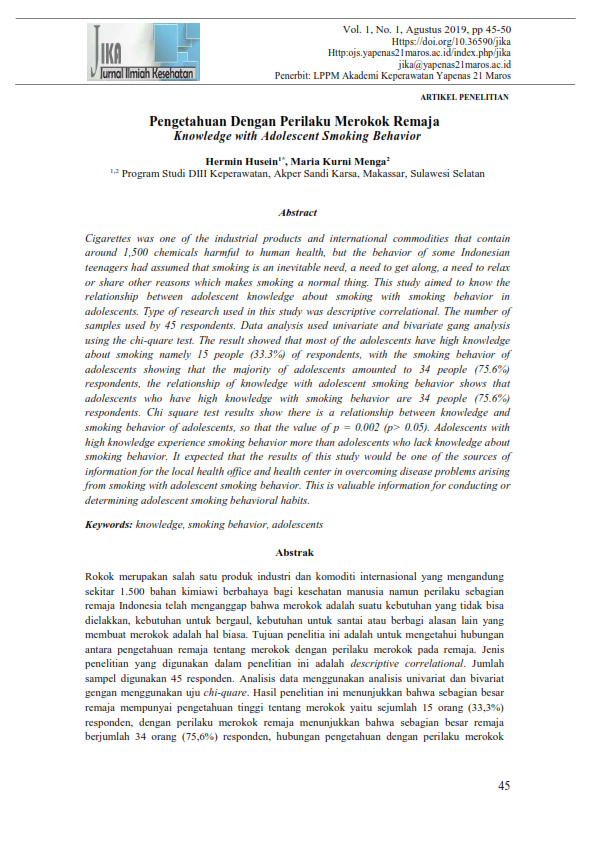Knowledge with Adolescent Smoking Behavior
DOI:
https://doi.org/10.36590/jika.v1i1.7Keywords:
knowledge, smoking behavior, adolescentsAbstract
Cigarettes was one of the industrial products and international commodities that contain around 1,500 chemicals harmful to human health, but the behavior of some Indonesian teenagers had assumed that smoking is an inevitable need, a need to get along, a need to relax or share other reasons which makes smoking a normal thing. This study aimed to know the relationship between adolescent knowledge about smoking with smoking behavior in adolescents. Type of research used in this study was descriptive correlational. The number of samples used by 45 respondents. Data analysis used univariate and bivariate gang analysis using the chi-quare test. The result showed that most of the adolescents have high knowledge about smoking namely 15 people (33.3%) of respondents, with the smoking behavior of adolescents showing that the majority of adolescents amounted to 34 people (75.6%) respondents, the relationship of knowledge with adolescent smoking behavior shows that adolescents who have high knowledge with smoking behavior are 34 people (75.6%) respondents. Chi square test results show there is a relationship between knowledge and smoking behavior of adolescents, so that the value of p = 0.002 (p> 0.05). Adolescents with high knowledge experience smoking behavior more than adolescents who lack knowledge about smoking behavior. It expected that the results of this study would be one of the sources of information for the local health office and health center in overcoming disease problems arising from smoking with adolescent smoking behavior. This is valuable information for conducting or determining adolescent smoking behavioral habits.
Downloads
References
Brigham J, Henningfield JE, Stitzer ML. 1991. Smoking relapse: a review. International Journal of the Addictions, 25(sup9), 1239–1255.
Gatchel RJ. 2004. Comorbidity of chronic pain and mental health disorders: the biopsychosocial perspective. American Psychologist, 59(8) : 795.
Kementrian Kesehatan. 2012. Aliansi Bupati/Walikota dalam Pengendalian masalah kesehatan akibat tembakau dan penyakit tidak menular. In Kementrian Kesehatan. Jakarta.
Munir M. 2018. Pengetahuan dan sikap remaja tentang risiko merokok pada santri mahasiswa di Asrama Uin Sunan Ampel Surabaya. Klorofil. 1(2): 93-104
Notoadmojo Soekidjo. 2003. Pendidikan dan perilaku kesehatan. Jakarta: Rineka Cipta.
Roan S. 2009. On the τ (2)-model in the chiral potts model and cyclic representation of the quantum group Uq (sl2). Journal of physics a: Mathematical and theoretical. 42(7) : 72003.
Sirait AM, Pradono Y, Toruan IL. 2002. Perilaku merokok di Indonesia. Buletin Penelitian kesehatan. 30(3): 139-152.
Sugiyono. 2010. Metode penelitian pendidikan pendekatan kuantitatif, kualitatif dan R&D. Bandung: Alfabeta.
Sutarno S, Susanti S. 2016. Pengendalian perilaku merokok: Action research pada mahasiswa kesehatan dengan pendekatan Ipk-Rae (Identifikasi-Pendidikan kesehatan-komitmen-rencana-aksi-evaluasi). Jurnal kesehatan Al-Irsyad, IX (2):70–80.
Walgito B. 2003. Psikologi suatu pengantar. Andi Offset : Yogyakarta.
WHO [World Health Organization]. 2018. Tobacco factsheet Indonesia: Heart disesase and stroke are the commonest ways by which tobacco kills people. WHO: Regional office for South-East Area.









